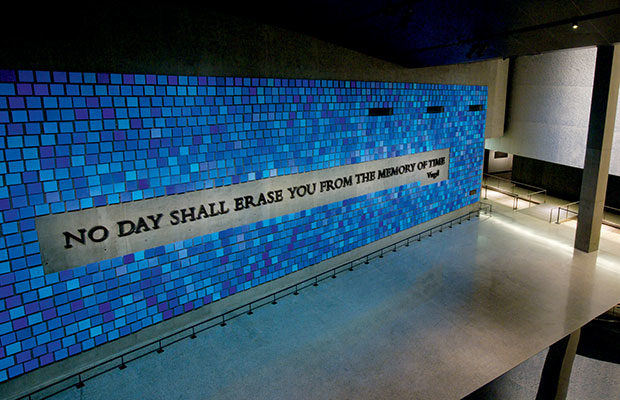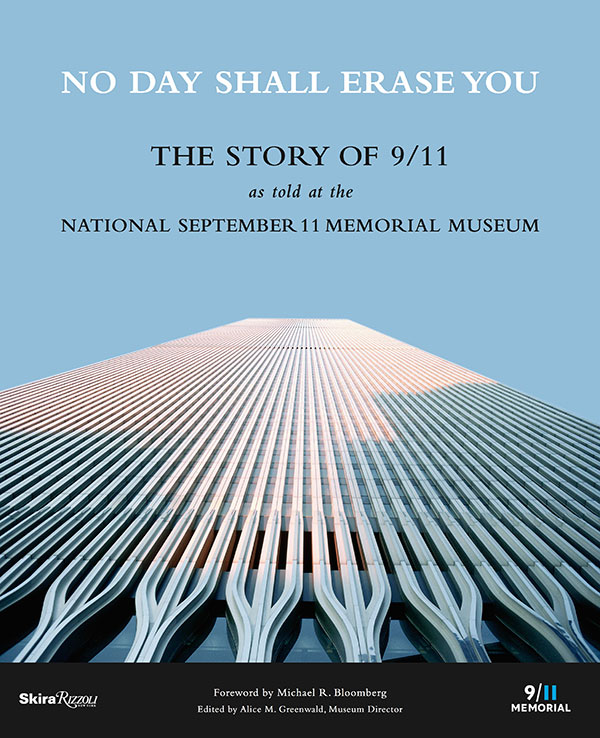 Memorial Hall. "No Day Shall Erase You from the Memory of Time", Tom Joyce, 2014. Steel. "Trying to Remember the Color of the Sky on That September Morning", Spencer Finch, 2014. Watercolor on paper. | © Jin S. Lee
Memorial Hall. "No Day Shall Erase You from the Memory of Time", Tom Joyce, 2014. Steel. "Trying to Remember the Color of the Sky on That September Morning", Spencer Finch, 2014. Watercolor on paper. | © Jin S. Lee
Feature
No Day Shall Erase You: The Story of 9/11 as told at the National September 11 Memorial Museum
No Day Shall Erase You: The Story of 9/11 as told at the National September 11 Memorial Museum
Edited by Alice M. Greenwald, Museum Director
SkiraRizzoli, 2016
I remember every detail of the morning of September 11, 2001. My husband and I were just leaving the house to vote in the Democratic primary at a school nearby and saw the news that a small plane had hit the World Trade Center. Walking to the polls, we learned it was much more than that. By the time I reached my office, the second tower had been hit, as well as the Pentagon, and the tragedy aboard Flight 93 was unfolding. In the following days, weeks, and months after September 11, we were flooded with complicated feelings, conflicting news stories, and frightening images.
The September 11 National Memorial & Museum, which opened on September 11, 2011, tells the story of these events, including the February 26, 1993 attack on the World Trade Center. No Day Shall Erase You tells the story of the complicated process of creating the museum and the memorial, and the foreword by former New York City mayor and memorial chairman Michael Bloomberg describes this monumental task, which included endless meetings and community forums, and the involvement of not just the memorial’s board of directors, architects, designers, and advisers but also family members of those who perished, survivors, rescue workers, representatives from the New York City Police Department, Fire Department, Port Authority Police Department (PAPD), local residents, downtown businesses, interfaith clergy, colleagues in the museum and cultural communities, and government personnel.
Beautifully illustrated with photographs of the museum and memorial, and essays from the Museum & Memorial staff, No Day Shall Erase You details all the issues that went into planning a museum and memorial that was fraught with emotion and delicate issues. Should artifacts be exhibited, as they might possibly contain dust that included microscopic human remains? Should the story of the hijackers be told and should the cockpit recordings by part of it? And how would the unidentified remains by housed? There was a question of developing a narrative that included audio recordings from survivors, witnesses, and others involved in the events of that day and the ongoing search and rescue operations, and how they could be accessed with some degree of privacy by the listener. Among the many images from September 11, some of the most tragic were those of people who had to make the decision to jump from the upper floors or perish in the fire and dense smoke. How could these be sensitively displayed?
Early in the process, planners chose a quote from Virgil’s Aeneid that summed up the mission of the museum and memorial—“No day shall erase you from the memory of time.” Artist Spencer Finch’s installation Trying to Remember the Color of the Sky on That September Morning, was chosen to illustrate that quote, and is made of 2,983 individually painted squares, representing each victim of September 11. While the museum and memorial tell the story of this unforgettably tragic day, it also includes incidents of generosity, bravery, and compassion and images of memorials from all over the world that showed the goodness of humanity.










